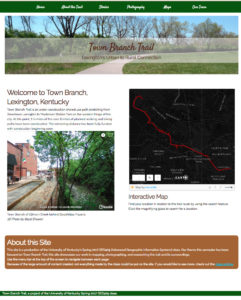Lexington, Kentucky was founded in the summer of1775 at the dawn of the American Revolution. A small band of frontiersmen gathered around a fire received word that a rabble of colonists had defeated British troops in a skirmish at Lexington, Massachusetts. To commemorate this exciting news, they decided to name the lush spring-fed wilderness in which they camped in the battle’s honor. Pioneers traveling south from the Ohio River or west through the Cumberland Gap traced their way to Lexington along buffalo trails over rolling savannah and by way of meandering forested waterways.
John Filson, biographer of Daniel Boone, shows us in a map from 1784 what pioneer Kentucky looked like.
In “Song of Myself†Walt Whitman imagines one of these early frontiersmen,
“A Kentuckian walking the vale of the Elkhorn in deer-skin leggingsâ€
These pioneers chose to set down roots in Lexington along the banks of the Town Branch of Elkhorn Creek because of the rich fertile soil and multitude of artesian springs running the year round. Within a few short years a collection of log cabins clustered around a stockade gave way to a burgeoning town laid out along a generous creek-side commons. The valuable exports of bourbon, tobacco, and pedigreed cattle soon made Lexington the hub of a prosperous Bluegrass Region, and the capital of America’s first frontier. Within two generations of its founding Lexington had become a town of great wealth, sophistication, and refinement. By the time the Marquis de Lafayette came to visit his namesake county in 1825, Lexington had become known as the “Athens of the West†for its free public library, a university which boasted schools of medicine and law, and for architecture as refined as any in Philadelphia or Boston. And a young Lexington lawyer by the name of Henry Clay held our nation’s Congress in his thrall.
By 1830 Lexington had one of the first railroad charters in the nation.
Lexington also became fertile ground for religion, forming many of the first congregations west of the Appalachians. A pair of vibrant African-American congregations trace their common history back to 1790. The place names of Mt. Tabor, Mt. Horeb, Pisgah, and Zion hark back to this era of great awakening.
Other place names around Lexington honor the revolution and early republic. Fayette County was named in 1780 in honor of the Marquis de Lafayette and downtown streets bear names like Madison, Jefferson, and Constitution in honor of our nation’s founding.
By the time of the Civil War, despite Lexington’s wealth, its national ascendancy had long been eclipsed by more westward river cities along the Ohio and the Mississippi and its lack of navigable waters consigned it to a more modest agrarian splendor. But to this day Lexington has carefully protected its precious farmland with an urban growth boundary and with a nationally acclaimed program for farmland protection.
Lexington is even rediscovering its roots along the Town Branch of the Elkhorn Creek, setting up a public greenway that will follow this historic waterway from the city out to pioneers houses, springs, and Bluegrass countryside.
 During the spring 2017 semester at the University of Kentucky, a group of 18 students in GEO 409 (Advanced Topics in GIS) created a website of maps for Town Branch Trail. The students focused on a completed alignment for the trail, which has been funded and partially completed during class. Students participated with a full spectrum of map-making and publishing; they GPS mapped and photographed points of interest, created topographic maps of the trail corridor, and made detailed, interactive maps using 3d data for building structures.
During the spring 2017 semester at the University of Kentucky, a group of 18 students in GEO 409 (Advanced Topics in GIS) created a website of maps for Town Branch Trail. The students focused on a completed alignment for the trail, which has been funded and partially completed during class. Students participated with a full spectrum of map-making and publishing; they GPS mapped and photographed points of interest, created topographic maps of the trail corridor, and made detailed, interactive maps using 3d data for building structures.